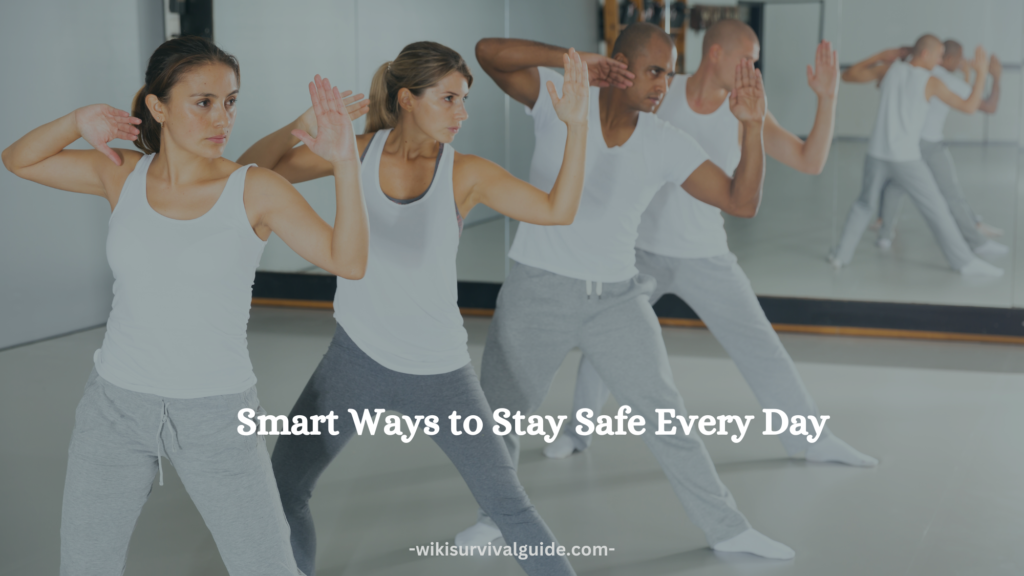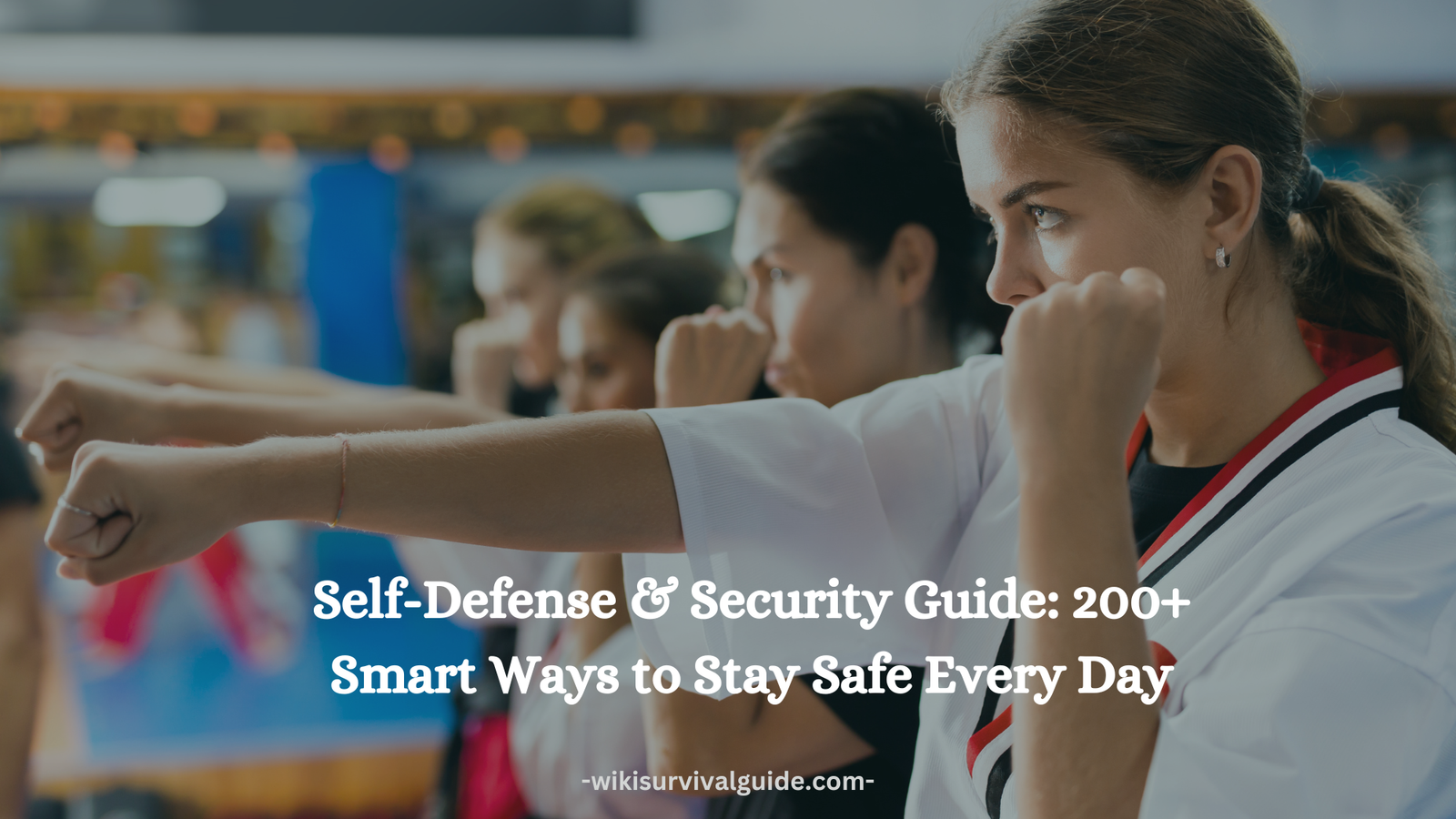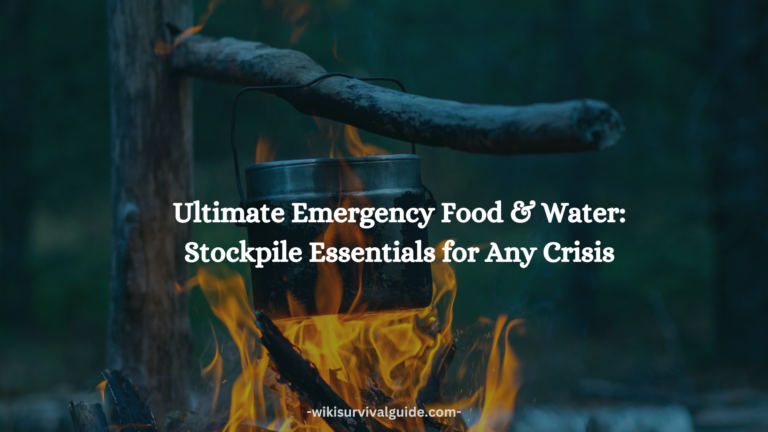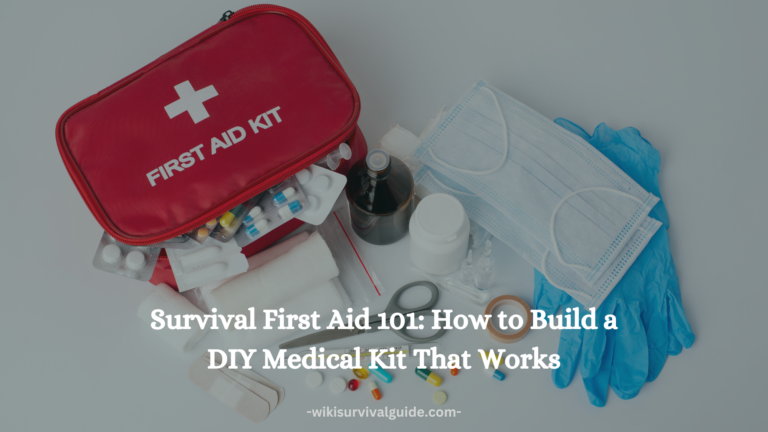Staying safe in today’s world requires more than just common sense—it demands preparation, awareness, and action. Whether you’re at home, in public, or online, threats can arise unexpectedly. This Self-Defense & Security Guide: 200+ Smart Ways to Stay Safe Every Day will provide you with actionable strategies to protect yourself, your loved ones, and your belongings.
From urban survival strategies to home defense tactics, we’ll cover everything you need to stay secure. Let’s dive in and make safety a top priority!

Situational Awareness and Risk Assessment
Understanding Situational Awareness
Situational awareness is a crucial skill that helps individuals stay alert and respond to potential dangers before they escalate. It involves actively observing surroundings, recognizing unusual behavior, and making informed decisions based on the environment. Many incidents can be prevented simply by being more aware of what is happening around you.
The key to situational awareness is avoiding complacency. When people become too comfortable in familiar settings, they may overlook potential threats. Whether at home, at work, or in public, staying attentive to changes in behavior, environment, and unusual activities can make a significant difference in personal safety.
Techniques to Improve Awareness
- Avoid distractions – Refrain from using mobile devices in unfamiliar or high-risk areas.
- Use all senses – Observe, listen, and even be aware of unusual smells that may indicate a threat.
- Assess exits and escape routes – Identify ways to leave a location safely in case of an emergency.
- Trust your instincts – If something feels off, take action rather than dismissing it.
Risk Assessment for Everyday Situations
Risk assessment helps individuals analyze potential threats before taking action. This includes:
- Home security: Checking locks, installing security cameras, and ensuring outdoor lighting deters intruders.
- Public safety: Being aware of who is nearby, avoiding isolated areas, and staying near well-lit, busy streets.
- Cybersecurity: Using strong passwords, avoiding public Wi-Fi for sensitive transactions, and not oversharing personal information online.
By combining situational awareness with risk assessment strategies, individuals can reduce vulnerabilities and increase their ability to respond effectively in emergencies. Practicing these skills regularly makes them second nature, enhancing overall security in daily life.
Home Security Strategies
Strengthening Physical Security
A strong home security system starts with reinforcing entry points. Intruders often target weak spots such as poorly locked doors, unsecured windows, or garages. Homeowners should take the following measures to improve home security:
- Install deadbolt locks on all exterior doors for added strength.
- Use security bars or reinforced glass on ground-floor windows.
- Secure sliding doors with a bar or track lock to prevent forced entry.
Additionally, motion-sensor lighting around entrances helps deter potential intruders. Lights should be installed near doors, pathways, and driveways to eliminate dark hiding spots.
Smart Home Security Technology
Modern technology plays a key role in home security. Smart devices provide real-time alerts and allow homeowners to monitor their property remotely.
- Security cameras with mobile access let users check live footage from anywhere.
- Smart doorbells with two-way communication enable interaction with visitors without opening the door.
- Automated alarm systems detect unauthorized entry and notify authorities immediately.
These technologies provide convenience and peace of mind by offering real-time security monitoring.
Safe Habits to Maintain Home Security
Beyond physical security, daily habits contribute to home safety. Simple but effective precautions include:
- Never leaving spare keys outside. Instead, give a key to a trusted neighbor or use a secure lockbox.
- Keeping curtains or blinds closed at night to prevent outsiders from seeing inside.
- Not announcing travel plans online to avoid making the home a target for burglars.
By combining structural security measures, smart technology, and responsible habits, individuals can significantly lower their risk of home invasion and unauthorized entry.
Personal Safety in Public Places
Awareness and Prevention Strategies
Public spaces are unpredictable, making personal safety a top priority. Whether walking alone, using public transportation, or visiting crowded areas, being proactive reduces risk.
- Stay in well-lit areas and avoid deserted streets, alleys, or parking garages.
- Hold belongings securely to prevent pickpocketing or snatch thefts.
- Trust your instincts – If a situation feels unsafe, leave immediately.
Responding to Unwanted Attention or Harassment
Encountering aggressive individuals can be distressing. Knowing how to respond can help avoid escalation.
- Use confident body language to appear strong and in control.
- Maintain a safe distance from strangers who make you uncomfortable.
- Politely but firmly disengage – Avoid engaging in unnecessary conversations.
- Seek assistance from authorities, store employees, or bystanders when necessary.
Using Public Transport Safely
Public transportation is a common area where personal safety concerns arise. Steps to stay secure include:
- Sit near exits to leave quickly if necessary.
- Stay aware of surroundings and avoid falling asleep or wearing noise-canceling headphones.
- Report suspicious behavior to transit security or law enforcement.
By maintaining awareness and setting boundaries, individuals can confidently navigate public spaces while minimizing risks.
Self-Defense & Security Guide Training
The Importance of Learning Self-Defense
Self-defense training is essential for handling unexpected threats. It not only teaches physical skills but also builds confidence, mental resilience, and quick decision-making abilities. Learning self-defense empowers individuals to protect themselves effectively.
Basic Self-Defense Moves
Knowing simple yet effective self-defense techniques can be lifesaving. Some essential moves include:
- Palm heel strike: Strike the attacker’s nose or chin to cause pain and disorient them.
- Knee strike: Aim at the groin to weaken the assailant’s ability to move.
- Escape from wrist grabs: Rotate your wrist toward the attacker’s thumb and pull away forcefully.
These moves focus on exploiting an attacker’s weak points, allowing escape even when faced with a larger opponent.
Choosing the Right Self-Defense Class
Various self-defense classes cater to different needs and skill levels:
- Krav Maga: A practical system emphasizing real-world self-defense scenarios.
- Brazilian Jiu-Jitsu: Teaches ground defense, useful for escaping holds and submissions.
- Kickboxing: Enhances striking skills while improving fitness and agility.
Regular training enhances muscle memory and reaction time, making self-defense techniques more instinctive in emergencies.
Travel Safety Tips and Precautions
Pre-Trip Planning for Security
Traveling to new destinations requires careful preparation to ensure safety. Before departure, consider the following:
- Research your destination – Learn about local safety risks, cultural norms, and areas to avoid.
- Make digital and physical copies of important documents like passports and visas.
- Share your travel itinerary with a trusted friend or family member.
Having a well-prepared plan minimizes risks and ensures smoother travel.
Staying Safe While Exploring
When traveling, staying vigilant and adapting to the environment is key:
- Use a money belt or concealed pouch to store cash and important documents.
- Avoid discussing travel plans with strangers – Criminals may target unaware tourists.
- Dress modestly to blend in and avoid attracting unnecessary attention.
Public spaces, markets, and tourist attractions can be hotspots for scams and thefts. Being discreet with valuables helps avoid being targeted.
Handling Emergencies Abroad
Despite careful planning, emergencies can still occur. Be prepared to handle unexpected situations:
- Know local emergency contact numbers for police, ambulance, and embassies.
- Keep an alternative financial option (backup credit card or emergency cash).
- Learn key phrases in the local language to request help if needed.
By prioritizing safety and preparation, travelers can enjoy their trips while reducing risks and potential dangers.
Digital and Cybersecurity Protection
Understanding Cyber Threats
In the modern world, digital security is as important as physical security. Cyber threats include identity theft, phishing scams, hacking, and data breaches. Attackers often exploit weak passwords, unsecured devices, and unverified links to gain unauthorized access to personal information.
Best Practices for Online Safety
To protect against cyber threats, follow these essential security measures:
- Use strong, unique passwords – Avoid using common words or easy-to-guess phrases. Instead, use a mix of uppercase, lowercase, numbers, and symbols.
- Enable two-factor authentication (2FA) – This adds an extra layer of security when logging into accounts.
- Be cautious with public Wi-Fi – Avoid accessing sensitive information, such as banking details, on unsecured networks. If necessary, use a Virtual Private Network (VPN) for added protection.
- Keep software and apps updated – Updates often fix security vulnerabilities that hackers can exploit.
Protecting Personal and Financial Information
Cybercriminals often target personal and financial data for fraud or unauthorized transactions. Take these precautions:
- Monitor bank statements regularly for any unauthorized activity.
- Avoid sharing personal details on social media that could be used for identity theft.
- Verify links before clicking – Phishing emails and fraudulent websites often look real but contain harmful malware.
By implementing these cybersecurity measures, individuals can safeguard their personal data and reduce the risk of digital attacks.
Emergency Preparedness and Response
Creating an Emergency Plan
Emergencies can strike at any time, whether it’s a natural disaster, fire, or personal safety crisis. Having a well-thought-out plan ensures a faster and more effective response.
- Identify potential risks – Consider natural disasters, health emergencies, or security threats in your area.
- Establish an evacuation plan – Know safe exits from your home, workplace, or other frequent locations.
- Assign emergency roles – Each family member should know their responsibilities in an emergency.
Building an Emergency Kit
A well-stocked emergency kit should contain:
- Water and non-perishable food (at least a three-day supply).
- First aid supplies including bandages, antiseptics, and prescription medications.
- Flashlights, extra batteries, and a whistle to signal for help.
- Important documents in waterproof storage (IDs, insurance policies, emergency contacts).
Staying Informed and Communicating During Emergencies
- Sign up for emergency alerts from local authorities.
- Have a designated meeting point in case family members get separated.
- Use text messages instead of calls – Networks may be overloaded during crises.
Emergency preparedness can save lives and minimize damage, making it essential for individuals and families.
Vehicle Security and Safe Driving Practices
Preventing Vehicle Theft
Vehicles are common targets for theft, but taking proactive measures can deter criminals:
- Always lock doors and roll up windows when leaving the car.
- Park in well-lit, secure areas with surveillance cameras when possible.
- Avoid leaving valuables in plain sight – Store bags, electronics, and personal items out of view.
- Use anti-theft devices such as steering wheel locks, GPS trackers, or car alarms.
Safe Driving Habits
Being a responsible driver reduces accident risks:
- Avoid distractions – Keep phones out of reach and focus on the road.
- Follow speed limits and traffic laws to prevent collisions.
- Maintain a safe distance from other vehicles, especially in bad weather conditions.
- Check blind spots before changing lanes to avoid unseen hazards.
Handling Roadside Emergencies
Unexpected breakdowns or incidents require quick thinking:
- Keep an emergency roadside kit with tools, flares, jumper cables, and a spare tire.
- Call for help immediately if stranded in an unsafe area.
- Stay inside the vehicle if in a high-risk location and wait for assistance.
By prioritizing security and safety while driving, individuals can protect themselves and others on the road.
Workplace Safety and Threat Prevention
Ensuring a Secure Work Environment
Every workplace should implement safety measures to protect employees from potential hazards. Key strategies include:
- Conducting regular safety drills for fire, evacuation, and medical emergencies.
- Installing security cameras and access control systems to prevent unauthorized entry.
- Encouraging an open-door policy where employees can report concerns without fear of retaliation.
Preventing Workplace Violence and Harassment
Workplace safety isn’t just about physical hazards—it also involves maintaining a positive and secure work culture. Steps to prevent violence and harassment include:
- Training employees on conflict resolution to de-escalate tense situations.
- Implementing strict anti-harassment policies and clear reporting procedures.
- Providing security escorts for employees working late or in high-risk areas.
Cybersecurity in the Workplace
Cyber threats also target businesses. Employees should:
- Avoid clicking suspicious links in emails to prevent malware attacks.
- Use secure company networks instead of public Wi-Fi for work-related tasks.
- Regularly update passwords and avoid sharing login credentials.
By fostering a culture of safety and preparedness, workplaces can minimize risks and ensure employee well-being.
Protecting Children and Family Members
Teaching Children About Personal Safety
Educating children about safety from a young age empowers them to make smart decisions. Key lessons include:
- Memorizing emergency contacts such as parents’ phone numbers and home address.
- Knowing how to call 911 and describe their location in case of emergencies.
- Understanding stranger danger – Teach children to never go anywhere with someone they don’t know.
Online Safety for Kids and Teens
With increased internet use, children face risks such as cyberbullying and online predators. Parents should:
- Monitor social media activity and set parental controls on devices.
- Teach children not to share personal details such as school name or location.
- Encourage open communication so children feel comfortable discussing online encounters.
Keeping Family Members Safe in Public
When out with family, follow these strategies:
- Establish a meeting point in case someone gets lost.
- Hold hands or stay close in crowded areas to prevent children from wandering.
- Teach children to seek help from security personnel if they feel unsafe.
By prioritizing safety education and proactive security measures, families can create a secure environment for their loved ones.
Non-Lethal Self-Defense Tools and Their Use
Choosing the Right Self-Defense Tool
Non-lethal self-defense tools are effective for personal protection without causing permanent harm. Some widely used options include:
- Pepper spray – Temporarily blinds and incapacitates an attacker.
- Personal alarms – Emits a loud sound to attract attention and deter threats.
- Tactical flashlight – Can disorient an attacker with its bright light.
- Self-defense keychains – Compact tools designed to be used in close encounters.
How to Use Self-Defense Tools Effectively
- Pepper Spray: Aim for the attacker’s eyes and spray in a short burst while maintaining distance. Move away immediately after use.
- Personal Alarms: Activate the alarm in a dangerous situation to draw attention and potentially scare off an assailant.
- Tactical Flashlight: Shine directly into the attacker’s eyes to disorient them and create an opportunity to escape.
- Self-Defense Keychains: Hold firmly and use them to strike sensitive areas like the eyes, throat, or groin.
Legal Considerations
- Research local laws regarding the possession and use of self-defense tools. Some jurisdictions have restrictions on certain devices.
- Only use when necessary – These tools are meant for protection, not aggression.
- Proper training – Take a self-defense class to learn how to use these tools effectively and responsibly.
Using non-lethal self-defense tools gives individuals an added layer of security while reducing the risk of legal complications.
Safe Social Media and Online Interaction
Protecting Personal Information
Social media platforms expose users to privacy risks. To stay safe:
- Limit personal details – Avoid sharing home addresses, phone numbers, or vacation plans.
- Adjust privacy settings – Restrict access to your posts and only accept friend requests from trusted individuals.
- Be mindful of location tags – Avoid sharing real-time location updates that could expose you to risks.
Identifying and Avoiding Online Threats
Cybercriminals often use social media for scams and identity theft. Stay vigilant by:
- Recognizing phishing attempts – Avoid clicking suspicious links in messages or emails.
- Verifying friend requests – Scammers may create fake profiles to gather personal information.
- Being cautious with direct messages – Do not share personal or financial information with strangers.
Best Practices for Safe Social Media Use
- Use strong passwords and enable two-factor authentication.
- Think before posting – Once something is online, it can be difficult to remove.
- Educate children and teens about online safety to prevent cyberbullying and exploitation.
By practicing safe social media habits, individuals can protect themselves from online dangers and identity theft.
Preventing Scams and Identity Theft
Recognizing Common Scams
Scammers use various tactics to deceive people. Common scams include:
- Phishing emails – Fraudulent emails that trick users into providing sensitive information.
- Phone scams – Callers impersonating government agencies, banks, or tech support.
- Online shopping scams – Fake websites that steal credit card details or fail to deliver goods.
Protecting Personal and Financial Information
- Monitor financial statements regularly for suspicious transactions.
- Use credit cards instead of debit cards for online purchases, as they offer better fraud protection.
- Shred sensitive documents to prevent identity thieves from accessing personal data.
What to Do If You Fall Victim to Fraud
- Report the scam to relevant authorities such as banks or fraud agencies.
- Freeze your credit if your financial information has been compromised.
- Change passwords immediately for affected accounts.
Preventing scams requires awareness and proactive security measures to safeguard personal information and financial assets.
Handling Dangerous Situations and Confrontations
Recognizing Potential Threats
Being aware of your surroundings can help you detect danger before it escalates. Warning signs include:
- Unusual behavior – Someone acting aggressively or following you.
- Verbal threats or intimidation – A sign that a situation may escalate.
- Feeling uneasy – Trust your instincts if something doesn’t feel right.
How to De-Escalate a Confrontation
- Stay calm and composed – Avoid reacting aggressively.
- Use clear, firm language – Politely but assertively ask the person to back away.
- Maintain a safe distance – Keep at least an arm’s length from a potential threat.
- Avoid direct eye contact – This can sometimes be perceived as aggression.
When to Take Action
If de-escalation fails and the situation becomes physically dangerous:
- Use self-defense techniques – Strike vulnerable areas like the eyes, nose, or groin.
- Create an opportunity to escape – Run towards a safe location such as a busy area or police station.
- Call for help – Use a personal alarm or yell for assistance.
Knowing how to respond to threats can significantly improve personal safety and reduce risks in confrontational situations.
Safe Use of Public Transportation
Staying Safe While Waiting
Public transportation areas can be hotspots for theft and harassment. Safety measures include:
- Stand in well-lit areas and near security personnel if possible.
- Avoid distractions – Keep phones and headphones away to stay alert.
- Trust your instincts – If a situation feels unsafe, move to a different area.
Safety on Buses and Trains
- Sit near the driver or conductor for added security.
- Keep belongings close – Use anti-theft bags or hold onto your items securely.
- Be aware of pickpockets – Keep wallets and phones in front pockets or zipped compartments.
- Avoid empty train cars or buses – More people around means added security.
Exiting Public Transportation Safely
- Be cautious when leaving – If you feel someone is following you, stay in a populated area.
- Avoid isolated shortcuts – Stick to well-lit, busy streets.
- Have your keys ready before reaching your destination to avoid fumbling at the door.
By staying aware and following safety precautions, individuals can use public transportation with confidence and reduced risk.
Neighborhood Watch and Community Safety
The Importance of Community Involvement
A strong community watch program is one of the most effective ways to enhance neighborhood safety. When residents look out for each other, crime rates decrease, and people feel more secure. Benefits of a neighborhood watch include:
- Crime prevention – A visible and active watch discourages criminals from targeting the area.
- Faster response to incidents – Residents can quickly report suspicious activity.
- Stronger community bonds – People get to know and trust their neighbors.
How to Start a Neighborhood Watch
- Organize a meeting with neighbors to discuss safety concerns.
- Partner with local law enforcement to receive guidance and training.
- Establish communication channels such as group chats, social media, or email lists.
- Create a schedule for patrols or observation shifts.
Everyday Community Safety Tips
- Encourage good lighting – Dark areas are attractive to criminals.
- Keep properties well-maintained – An unkempt neighborhood may signal neglect to criminals.
- Report suspicious behavior – Prompt reporting prevents potential crimes.
A well-organized neighborhood watch improves overall security and fosters a strong sense of community.
Understanding and Avoiding Common Threats
Identifying Everyday Security Risks
Criminals often look for easy targets. Common threats include:
- Pickpocketing – Often occurs in crowded areas like malls or public transport.
- Burglary – Unlocked doors and windows make homes vulnerable.
- Online fraud – Phishing emails and fake websites can trick people into revealing sensitive information.
How to Minimize Risks
- Stay alert in public – Avoid distractions like excessive phone use.
- Secure your home – Use locks, security cameras, and alarm systems.
- Verify financial transactions – Double-check emails and calls before providing sensitive data.
Reacting to Threatening Situations
- Trust your instincts – If something feels wrong, remove yourself from the situation.
- Use non-verbal signals – Maintain confident posture and avoid looking like an easy target.
- Know emergency contacts – Always have local emergency numbers saved.
By staying informed and vigilant, individuals can reduce the likelihood of becoming a victim.
Legal Aspects of Self-Defense and Personal Safety
Understanding Self-Defense Laws
Different regions have specific laws regarding self-defense. Some common legal principles include:
- Reasonable force – The level of force used must match the threat level.
- Duty to retreat – Some areas require individuals to escape a dangerous situation if possible before using force.
- Stand your ground laws – In certain jurisdictions, individuals can defend themselves without retreating if they feel threatened.
Knowing Your Rights and Responsibilities
- Learn local laws – Research what self-defense measures are legally acceptable in your area.
- Understand weapon restrictions – Carrying certain self-defense tools (like stun guns or pepper spray) may be regulated.
- Know when to call law enforcement – Reporting self-defense incidents properly can protect you from legal repercussions.
Handling a Self-Defense Situation Legally
- Call authorities immediately after using force to defend yourself.
- Provide factual information without exaggeration or speculation.
- Seek legal counsel if necessary to ensure compliance with self-defense laws.
Understanding self-defense laws prevents legal troubles and ensures individuals act within their rights.
Psychological Strategies for Confidence and De-escalation
Building Confidence in High-Stress Situations
A strong mindset is essential for personal safety. Confidence helps deter criminals and improves reactions to threats. Ways to build confidence include:
- Practicing situational awareness – Staying observant reduces surprise attacks.
- Training in self-defense – Familiarity with defense techniques improves reaction times.
- Developing assertiveness – Speaking with confidence can discourage potential threats.
De-Escalation Techniques for Avoiding Violence
Not all confrontations require physical defense. Effective de-escalation strategies include:
- Remaining calm – Keeping a steady voice and composed posture prevents escalation.
- Using non-threatening body language – Avoid aggressive gestures or direct eye contact in hostile situations.
- Providing an exit strategy – Allowing the aggressor a way to retreat can defuse tension.
Managing Fear and Panic
Fear can hinder effective decision-making. Techniques to control fear include:
- Controlled breathing – Slow, deep breaths reduce anxiety.
- Visualizing positive outcomes – Imagining successful resolutions boosts confidence.
- Repeating a calming phrase – A simple reminder like “I am in control” helps maintain focus.
Mastering psychological strategies enhances safety by preventing conflicts and ensuring clear decision-making.
Self-Defense for Vulnerable Groups
Women’s Self-Defense Strategies
Women often face unique safety challenges, making self-defense skills essential. Effective strategies include:
- Using everyday objects as weapons – Keys, pens, and purses can be used for defense.
- Learning escape techniques – Breaking holds and disengaging quickly is crucial.
- Setting clear verbal boundaries – A loud, firm “Back off!” can discourage attackers.
Self-Defense for Seniors
Older adults may have limited mobility, making alternative self-defense methods necessary:
- Using canes or walking sticks for balance and defense.
- Avoiding physical confrontation – Emphasizing situational awareness and de-escalation.
- Carrying personal alarms – These can alert others to an emergency.
Safety Tips for Children and Teens
Young individuals need to be aware of potential threats while maintaining their independence. Key lessons include:
- Trusting their instincts – If something feels wrong, they should leave immediately.
- Knowing safe places – Identifying locations like police stations or trusted businesses.
- Setting social media boundaries – Avoiding interactions with strangers online.
Tailored self-defense strategies empower vulnerable groups, ensuring they have the tools to protect themselves effectively.
Conclusion
Your safety is in your hands! By following this Self-Defense & Security Guide: 200+ Smart Ways to Stay Safe Every Day, you can minimize risks and react confidently in dangerous situations. Stay alert, be prepared, and prioritize security in all aspects of your life.
FAQs
1. What are the best self-defense tools for beginners?
Pepper spray, personal alarms, and tactical flashlights are excellent for beginners.
2. How can I improve my situational awareness?
Stay off your phone in public, scan your environment, and trust your instincts.
3. What should I do if I feel unsafe walking alone at night?
Walk in well-lit areas, carry a self-defense tool, and call a friend to stay on the line.
4. Are self-defense classes worth it?
Yes! Learning hands-on techniques can build confidence and prepare you for real situations.
5. How do I protect my home from break-ins?
Install security cameras, upgrade your locks, and avoid leaving spare keys outside.
Stay safe, stay smart, and always be prepared!




1 Comment